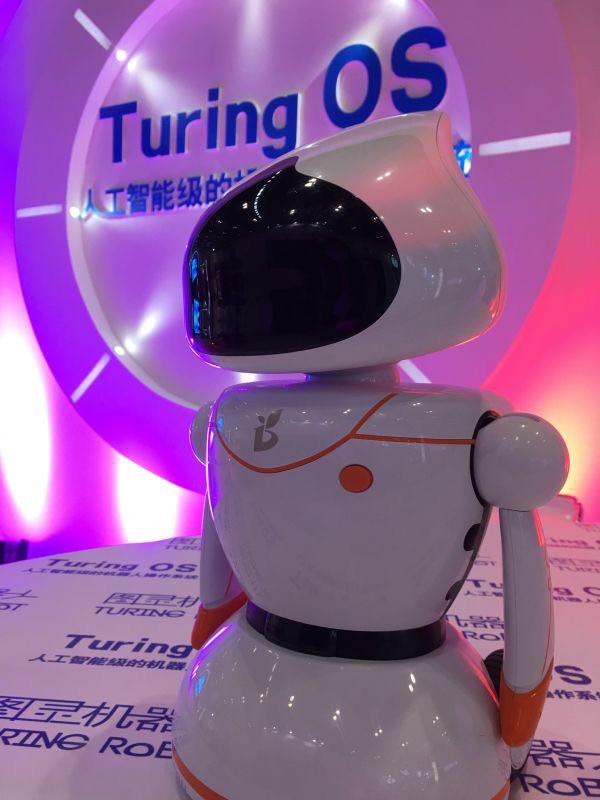A Popular Chinese Virtual Assistant Is Ready to Control Millions of Robots
One of China’s most popular smartphone assistants, HTC’s Hidi, has ambitions to serve as the voice and personality of countless home robots.
The company behind Hidi, Turing Robot, supplies voice recognition and natural-language processing technology for a growing array of hardware, including car systems developed by Bosch and home appliances from Haier. Now the company has developed an operating system for service robots. So far, Turing Robot provides the voice—and brains—for several popular Chinese home entertainment robots.
Supplying the intelligence for home robots could be a shrewd move. Scores of Chinese companies are making robots meant for use in the home. This is part of a larger push within China, backed by the government, to create a homegrown robotics industry. The goal is primarily to help bolster a dwindling workforce and upgrade its manufacturing sector, but it is also creating a boom in entertainment bots (see “China Is Building a Robot Army of Model Workers”).
Turing Robot, which received most of its funding from HTC, was created in 2010 by several artificial intelligence researchers and experts in natural-language processing at Beijing Jiaotong University. The company released its smartphone assistant in 2012 and its first software for personal robots in 2014. The company says it receives about a billion queries to its servers each day, mostly from Hidi.
The company’s latest robot software, called Turing OS, provides developers with a voice interface but also tools for text understanding, image recognition, and basic learning. The OS can also be used to control a robot’s physical movement, and simulate emotional states.

Poseidon Ho, chief designer at Turing Robot, says the company is rapidly expanding into robotics. “We are well known for speech,” Ho says. “Now we are doing computer vision, and allowing robots to be more interactive in terms of facial expression and actions.”
One application built into the Turing OS is an English education program aimed at young children. “Parents wouldn’t buy [such a robot] for their child just to play,” Ho says. “The educational purpose is very important.”
Turing Robot will host a developer conference in July. Ho says the company expects thousands of partners and individual developers to attend.
Voice interfaces are rapidly gaining traction beyond smartphones, and many big tech companies see them as a way to enter, and potentially dominate, the smart home market. U.S. tech giants, including Google, Apple, Amazon, and Microsoft, are all investing heavily in smart virtual assistants (see “10 Breakthrough Technologies: Conversational Interfaces” and “Amazon Working on Making Alexa Recognize Your Emotions”).
Jan Zhang, who tracks the Chinese robotics industry for the research firm IHS, says Turing Robot has a good head start in the home appliance market. “They’ve positioned themselves well,” she says. However, Zhang says there’s little data to show how big the home robot market is or how it is growing.
Certainly, it remains to be seen whether home robots are a long-term hit, in China or elsewhere. So far, such personal robots have not yet taken off in the U.S., although a growing number of robots are designed to interact with people in stores or factories.
With a long history of research on Chinese natural-language processing, Turing Robot may at least have a head start in providing voice interfaces to the Chinese market. Wei Keli, cofounder and chief technology officer of Turing Robot, says the company has built its language understanding on a large corpus of Chinese language data.
Elaine Chen, a senior lecturer at MIT Sloan business school and founder of a consulting company called ConceptSpring, says Turing Robot has an interesting business model in that it only supplies the middleware for hardware manufacturers. “They’re doing things in an interesting way,” Chen says. “But traditionally, this way it is harder to control your own destiny.”
Keep Reading
Most Popular
Large language models can do jaw-dropping things. But nobody knows exactly why.
And that's a problem. Figuring it out is one of the biggest scientific puzzles of our time and a crucial step towards controlling more powerful future models.
The problem with plug-in hybrids? Their drivers.
Plug-in hybrids are often sold as a transition to EVs, but new data from Europe shows we’re still underestimating the emissions they produce.
Google DeepMind’s new generative model makes Super Mario–like games from scratch
Genie learns how to control games by watching hours and hours of video. It could help train next-gen robots too.
How scientists traced a mysterious covid case back to six toilets
When wastewater surveillance turns into a hunt for a single infected individual, the ethics get tricky.
Stay connected
Get the latest updates from
MIT Technology Review
Discover special offers, top stories, upcoming events, and more.